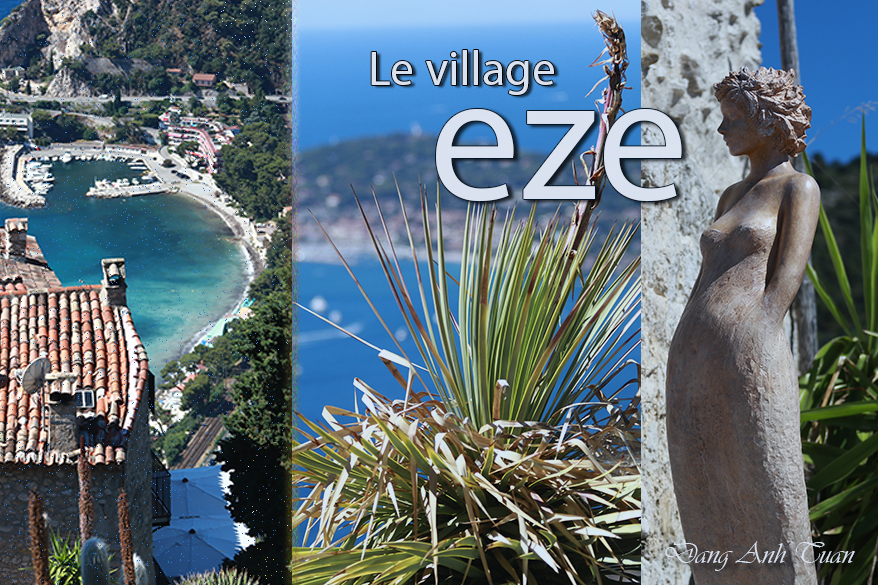Version vietnamienne
Version anglaise
Jardin exotique
Galerie des photos
Perché sur un piton rocheux de 429 mètres d’altitude entre le Ciel et la Mer avec ses ruelles pavées et sinueuses et ses maisons étagées bien fleuries le faisant passer pour un dédale, le village médiéval Eze est situé entre Nice et Menton et à 8km de la principauté de Monaco dans le département Alpes-Maritimes. Il est connu pour son église baroque Notre-Dame de l’Assomption et son jardin exotique aménagé sur les ruines de la forteresse médiévale. C’est ici qu’on voit s’installer une véritable harmonie où les sculptures longilignes en terre cuite de l’artiste-sculpteur Jean-Philippe Richard côtoient les plantes succulentes des régions désertiques d’Amérique du Nord et du Mexique (cactus, agaves, aloès, euphorbes etc.) et de la Méditerranée. C’est aussi ici que le visiteur peut contempler un panorama magnifique sur la Riviera française en contrebas. Le village est riche en histoire. À l’image de tous les villages de la région méditerranéenne, les Romains occupèrent ce lieu, dès le 3ème siècle après J.-C. en le faisant devenir un oppidum romain pour faire face à tous les envahisseurs. Puis c’est aussi par une petite porte nommée aujourd’hui « porte des Maures » que les Sarrasins réussirent à prendre la cité en l’an 900 à l’époque où ils dévastaient la Provence et la Ligurie pendant plus de 70 ans jusqu’à sa libération par le comte de Provence, Guillaume 1er. La cité fut rattachée ensuite en l’an 1388 à la couronne de Savoie qui apportait beaucoup de modifications à caractère défensif dans la protection de la cité par une double porte connue sous le nom « Poterne » avant d’être rattachée définitivement à la France lors d’un vote à l’unanimité des Ézasques les 15 et 16 avril 1860.
Toàn cảnh Riveira
Perched on a rocky peak 429 meters above sea level between the Sky and the Sea, with its cobbled and winding streets and its well-flowered terraced houses that make it seem like a maze, the medieval village of Eze is located between Nice and Menton and 8 km from the Principality of Monaco in the Alpes-Maritimes department. It is known for its Baroque church Notre-Dame de l’Assomption and its exotic garden laid out on the ruins of the medieval fortress. Here, a true harmony can be seen where the elongated terracotta sculptures of the artist-sculptor Jean-Philippe Richard stand alongside succulent plants from the desert regions of North America and Mexico (cacti, agaves, aloes, euphorbias, etc.) and the Mediterranean. It is also here that visitors can admire a magnificent panorama of the French Riviera below. The village is rich in history.
Like all the villages in the Mediterranean region, the Romans occupied this place from the 3rd century AD, turning it into a Roman oppidum to defend against all invaders. Then, it was also through a small gate now called the « Moor’s Gate » that the Saracens managed to take the city in the year 900, at a time when they were ravaging Provence and Liguria for more than 70 years until its liberation by the Count of Provence, William I. The city was then attached in 1388 to the Crown of Savoy, which brought many defensive modifications to protect the city with a double gate known as the « Poterne » before being definitively attached to France following a unanimous vote by the Ézasques on April 15 and 16, 1860.
Nằm trên một đỉnh núi đá cao 429 mét so với mực nước giữa Trời và Biển với những con đường lát đá và quằn quèo cùng những ngôi nhà nhiều tầng nở đầy hoa khiến nơi đây trông giống như một mê cung, ngôi làng thời trung cổ Eze được tọa lạc cách xa công quốc Monaco 8 cây số giữa hai thành phố Nice và Menton và ở trong địa phận Alpes-Maritimes . Làng nầy được biết đến với nhà thờ Notre-Dame de l’Assomption kiểu phong cách baroque và khu vườn nhiệt đới được hoàn tất trên phế tích của một pháo đài ở thời trung cổ. Chính tại đây, được thấy có sự hài hòa của các tác phẩm điêu khắc bằng đất nung thanh mảnh của nhà điêu khắc Jean-Philippe Richard được dựng bên cạnh các loài thực vật mọng nước đến từ các vùng sa mạc của Bắc Mỹ và Mexico (như xương rồng, cây thùa, lô hội, euphorbias, vân vân) và Địa Trung Hải. Cũng tại đây, du khách có thể nhìn xem một phong cảnh tuyệt vời của vùng duyên hải Pháp ở phía dưới. Ngôi làng nầy rất giàu về lịch sử. Giống như các làng ở khu vực Địa Trung Hải, người La Mã đã chiếm đóng nơi này từ thế kỷ thứ 3 sau Công nguyên bằng cách biến nó thành một thành lũy (oppidum) kiên cố để chống lại quân xâm lược. Sau đó, nhờ thông qua một cánh cửa nhỏ nay gọi là « cửa của người Moor », người Hồi giáo đã thành công chiếm được thành vào năm 900 khi họ tàn phá Provence và Liguria có hơn 70 năm cho đến khi được bá tước của Provence, Guillaume đệ nhất giải phóng. Làng nầy được thuộc sau cùng về vương quốc Savoie vào năm 1388. Vương quốc nầy thực hiện nhiều sửa đổi mang tính chất phòng thủ trong việc củng cố thành lũy qua cánh cửa đôi được biết đến nay với cái tên « Poterne » trước khi thành được trở về vĩnh viễn dưới quyền cai trị của Pháp trong một cuộc bỏ phiếu nhất trí của người dân ở Eze vào ngày 15 và 16 tháng 4 năm 1860.

